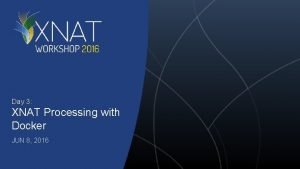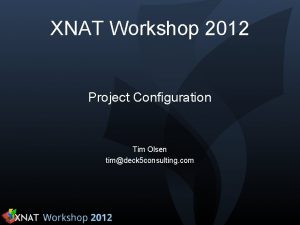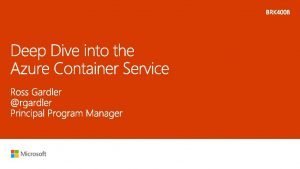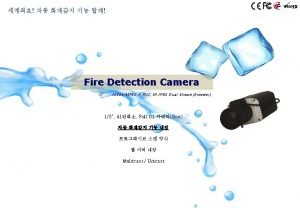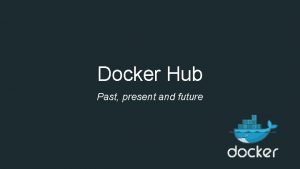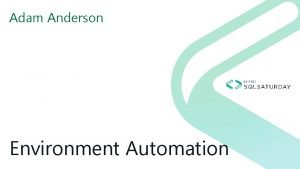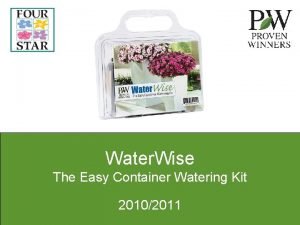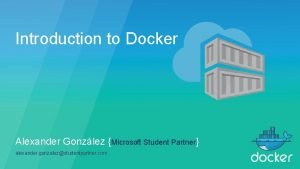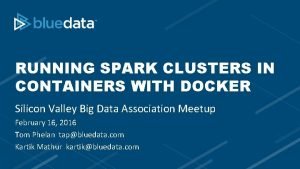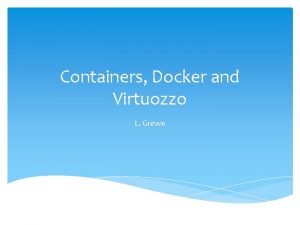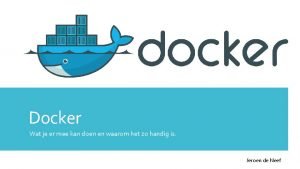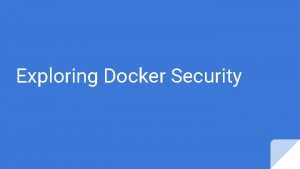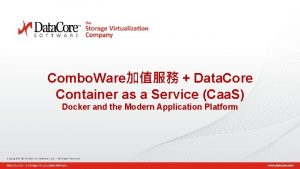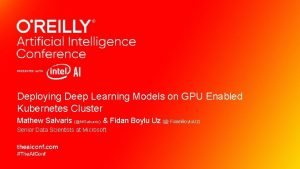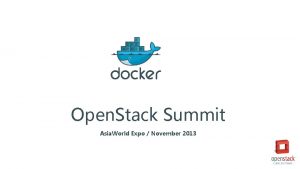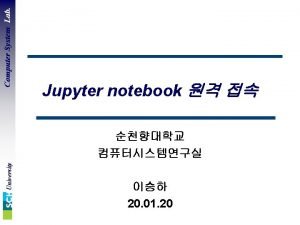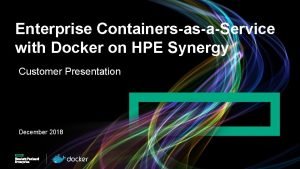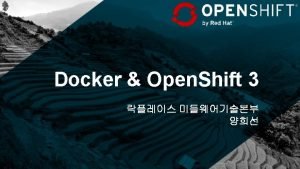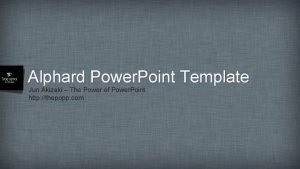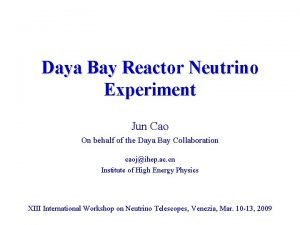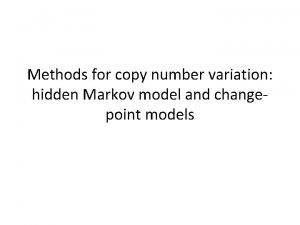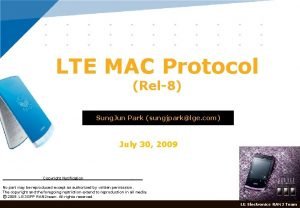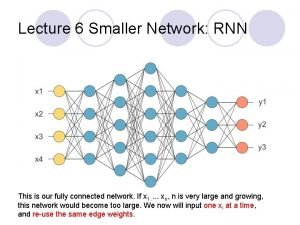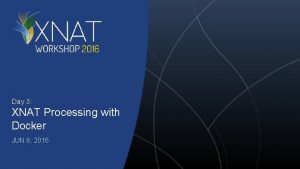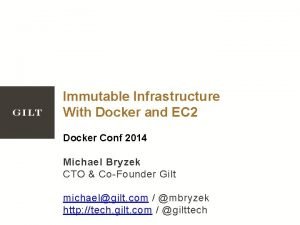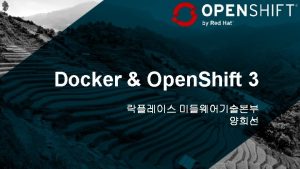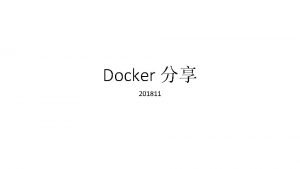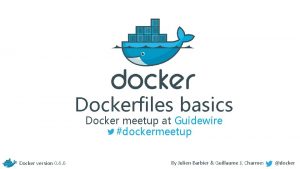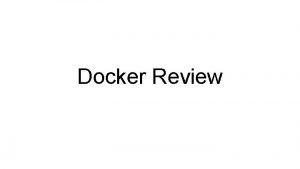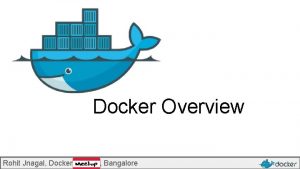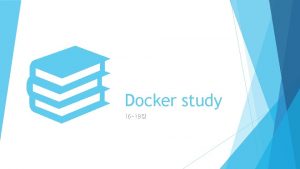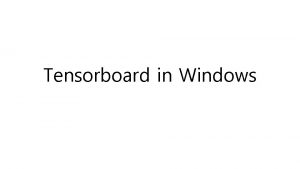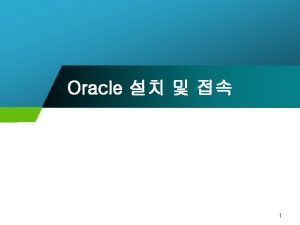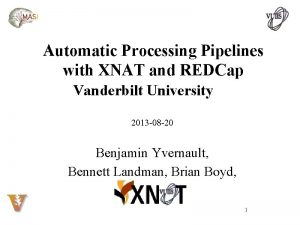Day 3 XNAT Processing with Docker JUN 8
















































- Slides: 48

Day 3: XNAT Processing with Docker JUN 8, 2016

Outline • • • XNAT Processing Docker XNAT Processing with Docker

XNAT Processing • Data are inside XNAT • Users want to execute external applications on data, outside XNAT

XNAT Processing — General Steps • • • Gather data from XNAT Launch executable Get outputs back into XNAT (sometimes)

Manual Execution • • Download data by hand (through GUI or REST API) Stage files in proper place by hand Launch executables by hand Gather outputs for upload by to XNAT

Manual Execution • Benefits – Flexible • Problems – Time consuming – Error-prone – Person executing commands must be expert in XNAT and executable – Person executing commands must have access to compute machines

Scripting • An expert writes a script that automates… – Downloading from XNAT – Running executables – Gathering outputs • Non-expert runs script

Scripting • Benefits – Transfer of expertise – Automation reduces errors – 100% flexible (in general) – Can use tools to abstract knowledge – Easy to share • Problems – Script writer must be expert in XNAT & executables – Script executor must log on to execution machines – Heterogeneous environments

XNAT Pipeline Engine • An expert writes a pipeline that automates… – Downloading from XNAT – Running executables – Gathering outputs • Non-expert runs pipeline

XNAT Pipeline Engine — Benefits • Pipelines are launched by XNAT – Launching user needs no access to compute nodes – Users can launch pipelines via UI, REST API, or automatically – Schemalink parameters have values provided by XNAT at launch time • • • Transfer of expertise (Pipeline writer to launching user) Automation reduced errors Resource descriptors for common tools can be reused

XNAT Pipeline Engine — Problems

XNAT Pipeline Engine — Problems • Writing pipelines has a steep learning curve – – Structure of pipeline XML How Engine executes pipeline XML How XNAT reads/launches pipeline XML Distinctions between Steps, Resource Descriptors, and executables • Setting up pipelines can be hard – Must manually place pipeline XML files on XNAT/compute machines – Must configure each pipeline on XNAT, and also on each project

XNAT Pipeline Engine — Problems • Pipeline UI – Default UI is not user-friendly – Custom UI is possible, but has its own problems • Pipeline writer must now also be a Java/HTML/Java. Script developer • Deploying custom Screen class requires shutting down, rebuilding XNAT • XNAT launches pipelines, and stores their state. Nothing else. – Cannot stop unwanted executions or restart failed executions. – Cannot pull any logs, on failure or success. Pipeline must push. – XNAT cannot handle data transfer. Pipeline must

New Process Execution Infrastructure Goals • Deep XNAT integration – – • • • Launchable through XNAT (UI, API, and automatically) Configurable through XNAT Deployable through XNAT understands how to launch, stop, restart, how to stage data, … Flexible (Workflows, scripts, brand-new or off-the-shelf) Easy to learn Leverage known third-party code

What I Need • Remotely launch executables from XNAT • Ensure they are: – Portable – Deployable remotely – Consistent

Docker

Docker —Terms to Know • • • Docker (engine) Docker server/host Docker image Docker container Docker Hub (generic: Docker Registry)

Docker — How to get it • Native on Linux • Mac/Windows: Docker Toolbox (docker, docker-compose, docker-machine, etc. ) • Mac: Homebrew • Mac/Windows: Native Docker currently in Beta

Docker Demo: Pull a Docker Image

Docker Demo: Build a Docker Image

Review • • • Processing XNAT data Intro to Docker Processing XNAT data with Docker…

XNAT + Docker Caution: Pre-alpha! Code & concepts will change.

XNAT + Docker

XNAT + Docker • • • Manage images on Docker server (pull, delete) Launch and manage containers Stage data to and from Docker server (a. k. a. execution node)

XNAT + Docker — Steps to Execution • • • Pull a Docker image Define the image within XNAT Define a Command Define an Action Execute an ACE (Action/Context Execution)

XNAT + Docker — Pull a Docker Image

XNAT + Docker — Docker Images • Must tell XNAT about Docker Image – Name – Docker Image ID – Labels • If we use XNAT to pull the image from a hub, we provide these image metadata at the same time

XNAT + Docker — Docker Images Demo: xnat/dcm 2 niix

XNAT + Docker — Commands

XNAT + Docker — Commands • Defines how to run a command in a Docker image • “docker run” command • environment variables • mounts • Can define variables that will be filled in with values at runtime • No XNAT-specific information required (but you can provide hints to XNAT)

XNAT + Docker — Commands Demo: dcm 2 niix command

XNAT + Docker — Actions

XNAT + Docker — Action • Defines a root XNAT object on which it can be executed (the “Context”) • Defines how to fill in Command variables from root object • Defines the resources to be staged for the Command’s input mounts, and to be created from the Command’s output mounts

XNAT + Docker — Action Demo: dcm 2 niix on a scan

XNAT + Docker — ACE • • • Action / Context Execution Action is a template for how to run something Context is a representation of where you are / what you’re looking at / what you want to execute an Action on. • ACE: fully resolves all template variables in Action and Command

XNAT + Docker — ACE Demo: Execute dcm 2 niix Action

XNAT + Docker — UI Demo: UI Wireframes with Will

Use Cases • XNAT User wants to run Freesurfer • XNAT Admin – Pulls Freesurfer Docker Image (or builds a new one) – Configures Command to launch the Image: Ex. “recon-all [subject dir]…” • XNAT User – Configures Action to execute Command from MR Sessions – Runs Freesurfer as an ACE by Executing the Action from an MR Session Context

Use Cases • XNAT User has a script that runs a few FSL commands • XNAT Admin – Builds a new Docker Image with FSL and the User’s script – Configures a Command to launch the Image • XNAT User – Configures an Action to execute the Command from MR Sessions – Runs their script as an ACE by Executing their Action from an MR Session Context

Use Cases • XNAT User has a script that runs a few FSL commands • XNAT Admin – Gathers information about script (language, requirements, etc. ) – Pulls FSL Docker Image (or builds a new one) – Configures a new Script Environment • XNAT User – – Adds their script to XNAT’s script repository Configures Command Configures Action Executes ACE

Script Environment • Rather than a single-application Docker Image, can use a generic container (e. g. python, R, MATLAB, nipype, Open. MOLE, etc. ) • Admin makes image available as Script Environment • Users can add scripts, configure them, and launch them as ACEs

Use Cases • Developer wants to make application available for XNAT users • Developer builds Docker Image with application + dependencies • XNAT Admin pulls Image, defines Command • XNAT Admin or User defines Action • User Executes ACE

Use Cases • Developer wants to make application available for XNAT users • Developer builds Docker Image with application + dependencies • Developer writes metadata into Docker Image that define Commands and Actions • XNAT Admin pulls Image • User Executes ACE

Future • Get feedback on design • Finish remaining major features – Resource importing – Monitoring – UI – Bulk execution on collections • Get a beta into your hands

Conclusion • Data are inside XNAT • Users want to execute external applications on data, outside XNAT

Conclusion • My focus • Make it as easy as possible to get data out of XNAT • Make it as easy as possible to run whatever you want from XNAT • Your focus • Think about how you can use this • Give me feedback

Contact me • • • jflavin@wustl. edu xnat_discussion Google group github. com/nrgxnat/container-service

 Xnat docker
Xnat docker Day 1 day 2 day 3 day 4
Day 1 day 2 day 3 day 4 Xnat workshop
Xnat workshop Day 1 day 2 day 817
Day 1 day 2 day 817 Advantages and disadvantages of docker
Advantages and disadvantages of docker Onvif docker
Onvif docker Docker meetup
Docker meetup Docker run detatched
Docker run detatched Gdb twitch
Gdb twitch Docker legacy applications
Docker legacy applications Ossim docker
Ossim docker Dockerfile run yum install
Dockerfile run yum install Openairinterface docker
Openairinterface docker Dripper docker
Dripper docker Docker microsoft office
Docker microsoft office Spark standalone docker
Spark standalone docker Docker microsegmentation
Docker microsegmentation Virtuozzo docker
Virtuozzo docker Docker
Docker Pest control docker
Pest control docker Agendav docker
Agendav docker Docker parameters
Docker parameters Wat is docker
Wat is docker Docker computer science
Docker computer science Wordle docker image
Wordle docker image How to detach docker
How to detach docker Comboware
Comboware Alibaba cloud russia
Alibaba cloud russia Kubernetes gpgpu
Kubernetes gpgpu Expo docker
Expo docker Docker jupyter notebook 접속
Docker jupyter notebook 접속 Hpe greenlake containers
Hpe greenlake containers 도커내부진입
도커내부진입 Gimnasio jun
Gimnasio jun Jun akizaki
Jun akizaki Jun flores
Jun flores Www.brainybetty.com
Www.brainybetty.com 51 ppt
51 ppt Jun sik his teeth before breakfast every morning
Jun sik his teeth before breakfast every morning 55 - 46
55 - 46 Jun akizaki ppt
Jun akizaki ppt Informel art
Informel art Jun cao
Jun cao Jun s. liu
Jun s. liu Dtch lte
Dtch lte Chua jun yi
Chua jun yi 05 jun 2015 networks say
05 jun 2015 networks say Ia64 processor
Ia64 processor Jun xu md
Jun xu md
